Kanchanaburi is a small town in western Thailand. It would probably go under the radar of Thai tourism if there wouldn’t have been one of the biggest Kanchanaburi sightseeing attractions: the Bridge on the River Kwai.
Popularized by the same-named Oscar-winning movie, this bridge laid foundations for the war tourism of Kanchanaburi, long before the invention of selfie sticks and the concept of bucket lists invaded the habits of today’s travelers.
In World War 2, Kanchanaburi was an important station of the Siam-Burma Railway. The Japanese aimed to connect the territories of today’s Thailand and Myanmar with a train track laid in the blood of the Allied prisoners of war and enslaved Asian laborers. The most famous outpost of this cruel project turned out to be the Bridge on the River Kwai.
Why are we even interested in sightseeing, if it will expose how blind we are?
The bridge, and in extreme cases even Kanchanaburi War Cemetery, turned out to be Kanchanaburi attractions in a completely inappropriate way! Taking silly poses and making duck faces in places where more than a hundred thousand people lost their lives, resembles dancing on someone’s grave.
Did social media destroy our brain cells? How in the hell did we become so insensitive? Can’t we understand contexts? If indeed we show that we are blind, why are we even interested in – Kanchanaburi sightseeing?
Whenever visiting places demanding respect, we should control our urge for constant camera-clicking. As I have both learned and taught in Lalibela, disrespectful photography could even bring you problems with the police!
Kanchanaburi trip as an ego trip

From afar, she looks like a statue. While the sun is setting down, she extends her arm and searches for the best angle. She probably already knows the one. But a slight change in degree and the light hits the front camera of her smartphone in a way that gives her profile that magical glare.
With some local flower tucked behind her ear, she stands there for minutes, and minutes, milking the golden hour benefits as much as possible. She stands there even after I finish the tour of the whole bridge. Still in a similar pose, still sending love to the camera, still looking like a statue.
At least nobody can object that these selfie-taking tourists only rush and go. Some of them clearly invest hours and hours in creating that perfect shot. It will become the social proof of their Kanchanaburi travel and an important monument on their always-hungry scale of self-esteem.

The worth of a trip stops being measured through the quality of experiences. It starts being replaced by numbers of hearts or thumbs up stamping some snapshots claiming to be an authentic document of our happiness or joy.
In reality, that fake smile was merely perfected. When tourists are taking selfies, one will notice how quickly that mask of happiness disappears after the camera makes its click.
At the Bridge on the River Kwai, I start reflecting on the fact that selfies additionally alienate us from others. When was the last time you asked a stranger to take a photo of you in front of some famous attraction? With the help of wide-angle lenses, long selfie sticks, and convenient tripods, modern travelers are all-in-one. A director, an actor, a cameraman, even a costume designer, if the shot requests a change of #ootd attire.
The Bridge on the River Kwai – the truth
In the Second World War (1939-1945), the Japanese captured tens of thousands of Commonwealth, Dutch and American service personnel. In 1942, they ordered the building of the 415-kilometer railway through the mountains of Thailand and Burma.
More than 60 thousand prisoners of war and 200 thousand forced laborers from the region constructed the railway in merely 16 months. The conditions were horrible. Malnutrition, jungle diseases, and brutal physical abuse were lethal for many.
Some 12 thousand POWs and half of the Southeast Asian civilian laborers (romusha) died here. The train project with a toll of 100 thousand lives became known as the Death Railway.

The Bridge 277, which inspired Pierre Boulle to write his novel “The Bridge over the River Kwai”, as well as the 1957 movie “The Bridge on the River Kwai” by David Lean, was never on – River Kwai!
The river that was running under this crucial railway bridge was the Mae Klong River! Even if Boulle was a prisoner of war, he had never been on the bridge and based his fiction on an incorrect assumption that it crossed the Khwae Noi River.
Due to the success of the book and the movie, and the pressure of post-war tourists, the Thai government was forced to adopt the mistake. They changed the name of the northern portion of Mae Klong to – Khwae Yai.
The conditions of working on the Death Railway were much worse than what Lean’s Academy Award-winning movie suggested. We could indeed try to forgive the smiling selfie-taking tourists the possible ignorant conviction that they are visiting a movie set and not the spot of the historical tragedy.
However, the movie bridge was never built on this river either! David Lean shot his blockbuster near Kitulgala, a small town in western – Sri Lanka!
Check the trailer of the “Bridge on the River Kwai” movie!
Kanchanaburi sightseeing gone wild
It is quite hard to decode the selfie-making spectacle on the Bridge on the River Kwai. All those pouting lips, balancing on the railway tracks, jumping and lying down, forming victory signs while standing on the most famous monument of the DEATH Railway… What is behind all those cheerful group photos?

Is the lack of knowledge behind the inappropriate celebration of achievement in Kanchanaburi? Did the visitors at least watch the movie as the beautified version of what happened here? Or is it possible that the Bridge on the River Kwai merely sounds like a reference worth including in that bucket list of places to visit before we die?
Is taking a smiling bridge selfie just one of the “best things to do in Kanchanaburi” before we even ask ourselves why?
With invisible bones and forgotten streams of blood, the Bridge on the River Kwai is stripped down to an amusement park! Is it the social pressure contagiously transferring from one visitor to another? Do we take inappropriate photographs because we are mimicking other people in our surroundings doing the same?
1:100.000, or how to shock Bridge on the River Kwai visitors
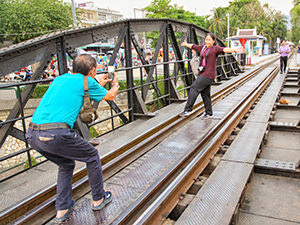
The first time the visitors of the Bridge on the River Kwai were described as shocked by the media, was in 2016 when an approaching train killed a Japanese man who tried to take a selfie. The reports said that people were screaming in panic!
You see, ONE lost life under the wheels of the train is more than enough to disturb people. They are clearly not desensitized!
Maybe Kanchanaburi needs to remind its visitors more clearly of the historical facts that did not reach them as shocking.
Degrees of “me, myself and I” narcissism
It would be unfair to say that Kanchanaburi sightseeing represents a unique example of how distorted modern traveling has become.
Throughout my world journey, I’ve witnessed travelers queuing in long lines to get some mediocre shot of touching an ancient carving in Rome. I’ve seen them fighting for the best spot while waiting for the Angkor Wat sunrise in Cambodia.
The bragging rights that come with a spectacular selfie are worth even risking one’s life in Norway. And then, many definitely cross the line of respect, such as those Indonesian gallery visitors who got famous for completely wrong reasons, or those that grab Juliet‘s breast in Verona for some cringy social media laugh.
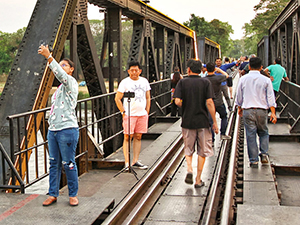
“Me, myself and I” narcissism controls modern tourists in a way that they stop controlling themselves. They damage the artworks, destroy the archeological sites, and endanger flora and fauna. All for the sake of some limited social media stardom.
At the moment, there are more than 400 million posts on Instagram with #selfie hashtag! The movement seems unstoppable. As soon as you publish your own selfie, thousands of others push it down the newsfeed, into oblivion. For most, it is not a discouraging event.
It seems it needs to be “almost too late” for society to take action when selfie-stimulated overtourism becomes dangerous. “The Beach”, a movie with Leonardo DiCaprio, made Phi Phi Islands unbearably famous. The Thai authorities had to close the beach to tourists.
Is the Bridge on the River Kwai unlucky because it doesn’t cross any coral reef that overambitious tourists may damage? Who needs to scream for the protection of the memories of war victims?
Death Railway Museum and Kanchanaburi War Cemetery
Kanchanaburi does provide background information for anyone interested in the context of its ‘attractions’.

Thailand-Burma Railway Centre (also known as Death Railway Museum) is a great place to learn about the history of the railway passing through Kanchanaburi.
It informs in detail about the timeline and the techniques of the construction, as well as about the living and dying conditions of the prisoners – the builders.
The entrance fee is 150 Baht (4,5 Euros). The museum ticket includes a complimentary coffee or tea refreshment. You can consume it in the bar on the upper floor, with a view of the Kanchanaburi War Cemetery.
The entrance to the cemetery, just across the road, is free.
Selfie in the graveyard
Nearly 7.000 prisoners of war buried at Kanchanaburi War Cemetery are enough to make most of the visitors think and reflect and feel respect.
I thought that silly selfies on the Bridge on the River Kwai were possible because of the lack of understanding of history. Hidden in the hordes of other tourists who also ignored the context, people were more prone to engaging in inappropriate behavior, I believed.

Then again, a graveyard is an internationally recognizable last resting place of people. We do not need to believe in life after death, but we should understand others could. Acting inappropriately in such places is truly desecrating.
A busty girl is lying down in the grass, like in some sexy music video. Her boyfriend is taking pictures from above. She twists her body, making love with the camera, utterly unaware of the thousands of other bodies lying around.
When I start to take photos of their photo session, they notice me but have no special reaction. She continues her posing and then absently checks how the photos turned out.
The grass is grass. The background is a background.
Pictures, pictures, more pictures

Another couple, both dressed in colorful Hawaiian shorts and shirts, approaches me. They want me to take a picture of them with graves as the background.
I accept reluctantly, naively thinking that the woman with a floral pattern on her hat and shirt, possibly lost a relative here.
My naivety becomes confirmed when they thank me for their smiling graveyard photo with “Merci beaucoup”. It is a graveyard with Australian, British, and Dutch graves!
Passing through the exit, I hear a local driver annoying the tourists he just brought to the cemetery. He offers to take pictures of them at the graveyard, several times! They just look at him in disbelief.
It seems that even locals here dehumanize Kanchanaburi tourist attractions. Perhaps, this is because Thai people did not share the destiny of other enslaved laborers. Consequently, they are not the first association with the tragic outcomes of the Death Railway.
Is it possible that the selfie invasion of Kanchanaburi is just not perceived as a serious problem?
Auschwitz against “selfie macht frei”
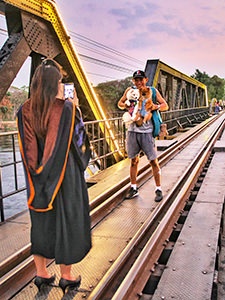
In March 2019, the Auschwitz Museum in Poland asked disrespectful visitors to stop posting selfies on the railway tracks leading into the building that marked the darkest moments of the Second World War.
“Remember you are at the site where over 1 million people were killed. Respect their memory. There are better places to learn how to walk on a balance beam than the site which symbolizes deportation of hundreds of thousands to their deaths”, the Polish museum tweeted.
The Bridge on the River Kwai and the Death Railway did not reach the gruesomeness of Auschwitz.
But we have already seen that the accidental death of one Japanese tourist is enough for people to feel compassion and take a step back from their irrational behavior.
There are places in the world where taking selfies has actually become illegal. Learn more about them at 52PerfectDays!
Kanchanaburi attractions as Disneyland
Without a clear and constant reminder that they are at the place of tragic memory, tourists will not stop training their balance on the tracks of the Death Railway. They will not stop experiencing Kanchanaburi good times in the worst way possible.
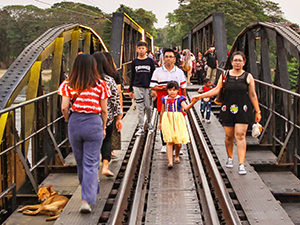
When we reduce the historic site to a mere construction of steel and concrete, it becomes an iconic Anything. It becomes a background for social media eccentricity.
Even if their train is not a rollercoaster, Kanchanaburi attractions become Disneyland. As if her parents understood that completely, one of the little visitors walked over the bridge in a Snow White costume. Maybe it was the most appropriate tribute paid to Kanchanaburi tourism of today!
Theme parks can become attractions even after they stop operating. Read about Nara Dreamland, the abandoned Japanese amusement park!
Fifteen minutes of shame
Standing on this World War bridge that led numberless victims to their death, I made an experiment. I raised my smartphone and tried to take a selfie. After that, I noticed my eyes checking left and right first, to see if anyone was looking, before taking a shot. My instinctive behavior was based on a feeling of shame.
In the world of social media likes, do we lack corrective mechanisms of shame? Do we need more “thumbs down” to get back to the initial human instinctive behavior?

In 2017, the Israeli artist Shahak Shapira shamed tourists who were taking inappropriate selfies at the Holocaust Museum in Berlin, Germany.
He launched the Yolocaust website where he republished these insensitive social media posts combined with the real footage from the Nazi concentration camps. The result was eye-opening, even for the selfie-takers!
After the world media shone an additional light on their “fifteen minutes of fame” (or shame?), the protagonists mostly apologized and removed controversial selfies from their Facebook and Instagram profiles.
I wonder if that’s exactly what the Bridge on the River Kwai needs. What can we do to eradicate the dehumanizing selfie pollution? Do we need to install the blood showers on the safety platforms on the bridge? Imagine turning them on at every golden hour! A red drizzle over the micro-influencers no Instagram filter could ever beautify!
Hear the history of the Death Railway from the mouth of the survivors and their Japanese captors!
Kanchanaburi info
Getting to Kanchanaburi
If you already have an interest in visiting Kanchanaburi, it makes sense to go there by train. It uses the same track line that was laid for the Death Railway.
Trains to Kanchanaburi leave from Thonburi Station in Bangkok, at 07:50 and 13:55. Depending on where you decide to stay, you can exit either at the central Kanchanaburi station or at the Kwai Yai Bridge Station. The train ticket from Bangkok to Kanchanaburi costs 100 Bahts (3 Euros).
I went back to Bangkok by bus. The buses and minibuses depart every hour. They will bring you to Mo Chit Bus Terminal (also known as the Northern Terminal) for 120 Bahts (3,60 Euros).
If you want to avoid backtracking to the capital, you can also continue exploring Thailand by taking a train to Hua Hin.
The best time to visit Kanchanaburi
The best time to visit Kanchanaburi is between December and February. This period just after the monsoon rains and before the humidity starts to rise again is when traveling is more bearable.
I visited Kanchanaburi town in March. The rising degrees already affected my walking from one side of the city to another. If you like exploring new towns on foot like me, remember to keep hydrated! Especially if you end up visiting it in April when the high temperatures can reach up to 38 degrees Celsius!
How to choose your Kanchanaburi hotel?

Kanchanaburi hotels with 5-star and 4-star labels are a lonely minority. They are located quite far from Kanchanaburi city center, as well as from the areas you will probably focus on.
More central, and dominating the 3-star level accommodation are Kanchanaburi hostels! Their quality often exceeds what one would expect at such type of a guesthouse.
Latima Boutique Hostel
Price per night: 32-41 Euro (King Room)

If you are looking for Kanchanaburi accommodation that would not break the bank, but still provide a decent place to stay in the vicinity of major Kanchanaburi attractions, Latima Boutique Hostel is your answer!
Hidden behind the light turquoise shutters that give it a countryside effect, Latima Boutique Hostel comes with a spacious reception area. Extravagant furniture and a model of a train made in mahogany wood dominate the pleasant space. It naturally continues into the outside where a swimming pool comes as a nice surprise!
Latima Boutique Hostel offers a range of peaceful sleeping corners, both for solo or group travelers. Their king rooms and dormitories which can fit between 4 and 10 guests, provide that feeling of cleanliness, no matter if we are talking housekeeping or interior design. It’s a pleasant space to retreat to after a long day of Kanchanaburi sightseeing.

Mornings here bring a thrill as well. Unlike at a typical hostel, one can expect a proper breakfast with changing menus, giving you an insight into Thai cuisine.
Just 900 meters away from the Bridge on the River Kwai, Latima Boutique Hostel is perfectly located for anyone who wants to explore Kanchanaburi’s most famous attraction, as well as various restaurant options in Maenamkwai Road.
If you want to visit Erawan National Park with its famous and probably most picturesque Thai waterfalls, the hostel staff will hail the bus when it passes by, so you don’t have to wait outside! Beyond the convenient location, this also makes an amazing – hospitality!
If you are considering booking this extraordinary Kanchanaburi hostel, check Latima’s best available prices on this link!
Did you like this article on the morbid version of Kanchanaburi sightseeing?
Pin it for later!
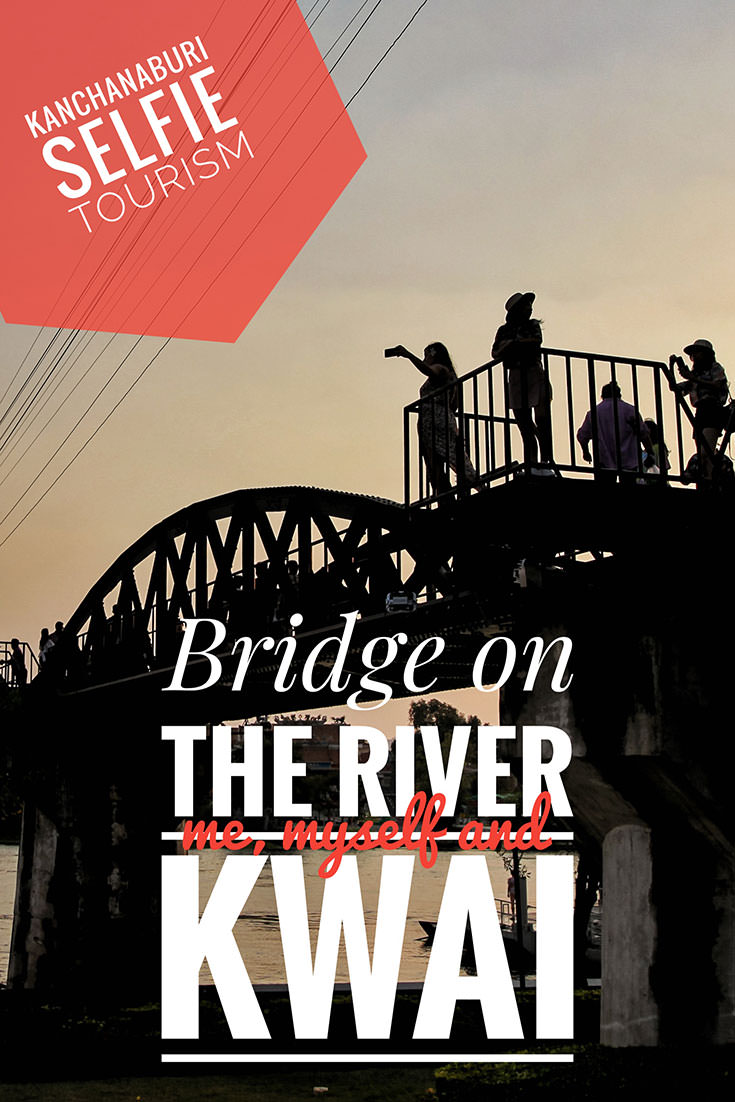
Disclosure: My stay at Latima Boutique Hostel was complimentary, but all opinions are my own. Also, this post contains affiliate links, which means if you click on them and make a purchase, Pipeaway might make a small commission, at no additional cost to you. Thank you for supporting our work!



I must admit as a WW2 History nut, I would want a selfie on that bridge also. I just hope I could do it in a respectful way to the Soldiers (POWs) that died building the railway.
I think there are DEFINITELY ways to take a selfie even on the Bridge on the River Kwai, and not cross the line of respect. As long as you are not balancing on the train tracks, as long as you are not making funny faces or poses, as long as you control the body language with the history of the bridge in mind, I’m sure you could do it without feeling shame. Then again, maybe it comes down to what do you do with the final photo – does it go to a private archive as your personal memory, or it becomes a public/promotional/social media proof of the fact that YOU have visited THE bridge? 🙂
This was really well done, Ivan. Thanks for sharing. The silly selfies at such a place of torment and death is shameful. On another note – I watched the trailer for the movie you have linked. The upbeat, rather patriotic sounding music they used in the trailer does not match the grotesque situation! I’ve never seen the whole movie, so maybe the music is approproate at some point – it just seemed misplaced there.